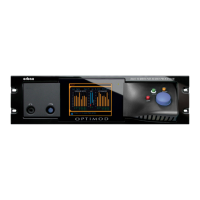1-18
INTRODUCTION ORBAN MODEL 8685
sion, it is the level above which serious crosstalk into other channels occurs, or the
level at which the amplifiers in the channel overload. In digital channels, it is the
largest possible digital word.
For metering, the transmission engineer uses an oscilloscope, absolute peak-sensing
meter, calibrated peak-sensing LED indicator, or a modulation meter. A modulation
meter usually has two components—a semi-peak reading meter (like a PPM), and a
peak-indicating light, which is calibrated to turn on whenever the instantaneous
peak modulation exceeds the overmodulation threshold.
Line-Up Facilities
Metering of Levels and Subjective Loudness
The meters on the 8685 show peak input levels, the peak output modulation, and
subjective loudness.
• Input levels are displayed using a VU-type scale (0 to –40dB), but the metering
indicates absolute instantaneous peak (much faster than a standard PPM or VU
meter). The maximum digital word at the input corresponds to the 0 dB point on
the 8685’s input meter.
• The output meter indicates the values of the digital samples at the output of the
8685’s audio processing, not at its digital outputs. 0 dB on the output meter cor-
responds to the setting of the digital output level control in the active Setup
(S
URROUND OUT 100% for the surround processing and 2.0 OUT 100% for the 2.0
processors). For example, if this control is set to –3 dBfs and the meter indicates 0
dB, the peak level at the 8685’s digital output is –3 dBfs.
• 0 dB on the meter also corresponds to the threshold of limiting of the 8685’s
look-ahead peak limiters, which prevent the processed audio’s level from increas-
ing beyond 0 dB.
If the output’s sample rate is set to a rate other than 48 kHz and or
passed through a D/A converter, the peak level of the output may in-
crease because of asynchronous resampling. (See page 1-14).
• The subjective loudness meter, labeled LOUDNESS LEVEL in the 8685’s GUI displays
either loudness measured by the EBU R 128-2010
1
standard or loudness meas-
ured using the CBS Technology Center algorithm developed by Jones and Torick
2
.
1
EBU Recommendation R 128, “Loudness normalization and permitted maximum
level of audio levels,” Geneva, August 2010. http://tech.ebu.ch/loudness
2
Bronwyn L. Jones and Emil L. Torick, “A New Loudness Indicator for Use in Broad-
casting,” J. SMPTE September 1981, pp. 772-777.

